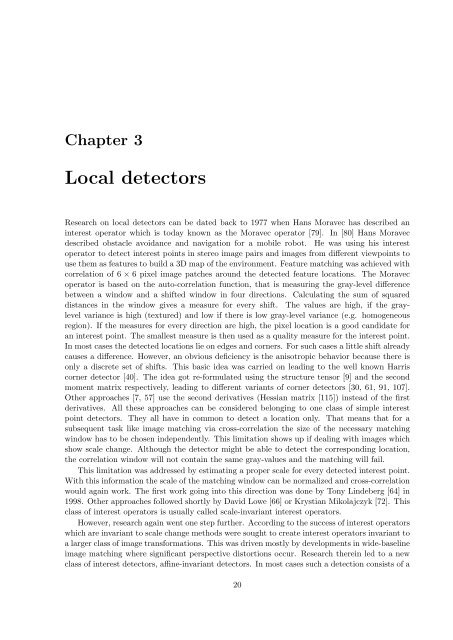PHD Thesis - Institute for Computer Graphics and Vision - Graz ...
PHD Thesis - Institute for Computer Graphics and Vision - Graz ...
PHD Thesis - Institute for Computer Graphics and Vision - Graz ...
You also want an ePaper? Increase the reach of your titles
YUMPU automatically turns print PDFs into web optimized ePapers that Google loves.
Chapter 3<br />
Local detectors<br />
Research on local detectors can be dated back to 1977 when Hans Moravec has described an<br />
interest operator which is today known as the Moravec operator [79]. In [80] Hans Moravec<br />
described obstacle avoidance <strong>and</strong> navigation <strong>for</strong> a mobile robot. He was using his interest<br />
operator to detect interest points in stereo image pairs <strong>and</strong> images from different viewpoints to<br />
use them as features to build a 3D map of the environment. Feature matching was achieved with<br />
correlation of 6 × 6 pixel image patches around the detected feature locations. The Moravec<br />
operator is based on the auto-correlation function, that is measuring the gray-level difference<br />
between a window <strong>and</strong> a shifted window in four directions. Calculating the sum of squared<br />
distances in the window gives a measure <strong>for</strong> every shift. The values are high, if the graylevel<br />
variance is high (textured) <strong>and</strong> low if there is low gray-level variance (e.g. homogeneous<br />
region). If the measures <strong>for</strong> every direction are high, the pixel location is a good c<strong>and</strong>idate <strong>for</strong><br />
an interest point. The smallest measure is then used as a quality measure <strong>for</strong> the interest point.<br />
In most cases the detected locations lie on edges <strong>and</strong> corners. For such cases a little shift already<br />
causes a difference. However, an obvious deficiency is the anisotropic behavior because there is<br />
only a discrete set of shifts. This basic idea was carried on leading to the well known Harris<br />
corner detector [40]. The idea got re-<strong>for</strong>mulated using the structure tensor [9] <strong>and</strong> the second<br />
moment matrix respectively, leading to different variants of corner detectors [30, 61, 91, 107].<br />
Other approaches [7, 57] use the second derivatives (Hessian matrix [115]) instead of the first<br />
derivatives. All these approaches can be considered belonging to one class of simple interest<br />
point detectors. They all have in common to detect a location only. That means that <strong>for</strong> a<br />
subsequent task like image matching via cross-correlation the size of the necessary matching<br />
window has to be chosen independently. This limitation shows up if dealing with images which<br />
show scale change. Although the detector might be able to detect the corresponding location,<br />
the correlation window will not contain the same gray-values <strong>and</strong> the matching will fail.<br />
This limitation was addressed by estimating a proper scale <strong>for</strong> every detected interest point.<br />
With this in<strong>for</strong>mation the scale of the matching window can be normalized <strong>and</strong> cross-correlation<br />
would again work. The first work going into this direction was done by Tony Lindeberg [64] in<br />
1998. Other approaches followed shortly by David Lowe [66] or Krystian Mikolajczyk [72]. This<br />
class of interest operators is usually called scale-invariant interest operators.<br />
However, research again went one step further. According to the success of interest operators<br />
which are invariant to scale change methods were sought to create interest operators invariant to<br />
a larger class of image trans<strong>for</strong>mations. This was driven mostly by developments in wide-baseline<br />
image matching where significant perspective distortions occur. Research therein led to a new<br />
class of interest detectors, affine-invariant detectors. In most cases such a detection consists of a<br />
20















